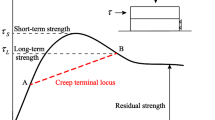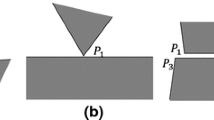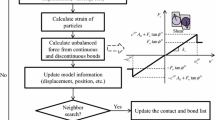Abstract
To improve the understanding of time-dependent responses of jointed rock mass, a new creep model is developed and implemented in UDEC to simulate creep deformations of jointed rock mass considering time-dependent deformations of both rock and joints. First, the implementation of the Time-to-Failure (TtoF) model for rock and the creep slipping model for joint is introduced. Then, creep simulations are conducted to study the influence of joint dip and confining stress on the long-term stability of rock masses using square models with a single joint. Time-dependent deformation of a moderately jointed rock mass is simulated using a pillar model with multiple joints. Finally, a case study of a high rock slope in western Norway is conducted and the creep deformation mechanisms of the rock mass are analyzed by comparing two slope models with different joint strength properties. It is found that there is no unstable movement on the potential sliding surfaces of the slope. The proposed creep model of jointed rock mass provides a novel approach to analyze structural failures of jointed rock mass under creep loading conditions.
Highlights
-
A new creep model for modeling time-dependent deformation behavior of jointed rock mass is proposed.
-
Time-dependent deformation of jointed rock mass is largely influenced by confinement and the angles between joint sets as well as the direction of the maximum principal stress.
-
The axial strain rate and the lifetime of moderately jointed pillars are governed largely by the applied stress.
-
There are no significant sliding deformations on the potential sliding surfaces of the Oppstadhornet rock slope from 2003 to 2011.
























Similar content being viewed by others
References
Aydan Ö, Ito T, Özbay U, Kwasniewski M, Shariar K, Okuno T, Özgenoğlu A, Malan DF, Okada T (2014) ISRM suggested methods for determining the creep characteristics of rock. Rock Mech Rock Eng 47:275–290
Bandis S, Lumsden A, Barton N (1981) Experimental studies of scale effects on the shear behaviour of rock joints. Int J Rock Mech Min Sci Geomech Abstr 1981:1–21
Barton N, Bandis S (1980) Technical note: some effects of scale on the shear strength of joints. Int J Rock Mech Min Sci 17:69–73
Barton N, Bandis S, Bakhtar K (1985) Strength, deformation and conductivity coupling of rock joints. Int J Rock Mech Min Sci Geomech Abstr 1985:121–140
Bhasin R, Kaynia AM (2004) Static and dynamic simulation of a 700-m high rock slope in western Norway. Eng Geol 71:213–226
Bieniawski Z (1993) Classification of rock masses for engineering: the RMR system and future trends. Rock Test Site Character 1993:5
Blikra LH, Skurtveit E, Braathern A (2002) Hazard evaluation of rock avalanches; the Baraldsnes-Oterøya area. In: Geological Survey of Norway (NGU) (Report no: 2001.108). pp 33
Brady BH, Brown ET (1993) Rock mechanics: for underground mining. Springer Science & Business Media, Berlin
Charles R (1958) Static fatigue of glass. I. J Appl Phys 29:1549–1553
Chen W, Wang Z, Wu G, Yang J, Zhang B (2007) Nonlinear creep damage constitutive model of rock salt and its application to engineering. J Rock Mech Eng 26:467–472
Duzgun H, Bhasin R (2009) Probabilistic stability evaluation of Oppstadhornet rock slope, Norway. Rock Mech Rock Eng 42:729
Esterhuizen G, Dolinar D, Ellenberger J (2011) Pillar strength in underground stone mines in the United States. Int J Rock Mech Min Sci 48:42–50
Feng J, Chuhan Z, Gang W, Guanglun W (2003) Creep modeling in excavation analysis of a high rock slope. Journal of Geotechnical and Geoenvironmental Engineering 129:849–857
Grøneng G, Nilsen B, Sandven R (2009) Shear strength estimation for Åknes sliding area in western Norway. Int J Rock Mech Min Sci 46:479–488
Grøneng G, Lu M, Nilsen B, Jenssen AK (2010) Modelling of time-dependent behavior of the basal sliding surface of the Åknes rockslide area in western Norway. Eng Geol 114:414–422
Habib P, Berest P (1993) Rock mechanics for underground nuclear waste disposal in France. Surface and underground project case histories. Elsevier, Berlin
Halakatevakis N, Sofianos A (2010) Strength of a blocky rock mass based on an extended plane of weakness theory. Int J Rock Mech Min Sci 47:568–582
Hermanns RL, Oppikofer T, Dahle H, Eiken T, Ivy-Ochs S, Blikra LH (2013) Understanding long-term slope deformation for stability assessment of rock slopes: the case of the Oppstadhornet rockslide, Norway. In; International conference on vajont–1963–2013, Genevois R, Prestininzi A (eds) Italian J. Eng. Geol. Environ., Book Ser, pp 255–264
Hu K, Feng Q, Li H, Hu Q (2018) Study on creep characteristics and constitutive model for thalam rock mass with fracture in tunnel. Geotech Geol Eng 36:827–834
Itasca (2015) Universal distinct element code (UDEC), Software version 6.0, Itasca Consulting Group, Minneapolis, USA
Jing L, Hudson J (2002) Numerical methods in rock mechanics. Int J Rock Mech Min Sci 39:409–427
Kabwe E, Karakus M, Chanda EK (2020) Time-dependent solution for non-circular tunnels considering the elasto-viscoplastic rockmass. Int J Rock Mech Min Sci 133:104395
Kachanov M (1980) Microcrack model for rock in elasticity [Ph. D. thesis]. Brown University, Providence, RI
Korzeniowski W (1991) Rheological model of hard rock pillar. Rock Mech Rock Eng 24:155–166
Kulatilake P, Ucpirti H, Wang S, Radberg G, Stephansson O (1992) Use of the distinct element method to perform stress analysis in rock with non-persistent joints and to study the effect of joint geometry parameters on the strength and deformability of rock masses. Rock Mech Rock Eng 25:253–274
Lau J, Gorski B, Conlon B, Anderson T (2000) Long-term loading tests on saturated granite and granodiorite. In: Ontario power generation, nuclear waste management division report, report No: 06819-REP-01300-10016 ROO
Li X, Konietzky H (2014) Time to failure prediction scheme for rocks. Rock Mech Rock Eng 47:1493–1503
Li X, Konietzky H (2015) Numerical simulation schemes for time-dependent crack growth in hard brittle rock. Acta Geotech 10:513–531
Li X, Kim E, Walton G (2019) A study of rock pillar behaviors in laboratory and in-situ scales using combined finite-discrete element method models. Int J Rock Mech Min Sci 118:21–32
Malan DF (1998) An investigation into the identification and modelling of time-dependent behaviour of deep level excavations in hard rock [Ph. D. Thesis]. South Africa: University of Witwatersrand
Martin C, Christiansson R (2009) Estimating the potential for spalling around a deep nuclear waste repository in crystalline rock. Int J Rock Mech Min Sci 46:219–228
Martin C, Kaiser P, Mccreath D (1999) Hoek-Brown parameters for predicting the depth of brittle failure around tunnels. Can Geotech J 36:136–151
Mercer K (2007) Time dependent deformational behaviour of unsupported rock slopes. Newsl Austr Centre Geomech 29:9–11
Nomikos P, Rahmannejad R, Sofianos A (2011) Supported axisymmetric tunnels within linear viscoelastic Burgers rocks. Rock Mech Rock Eng 44:553–564
Qi C, Fourie A (2019) Numerical investigation of the stress distribution in backfilled stopes considering creep behaviour of rock mass. Rock Mech Rock Eng 52:3353–3371
Riva F, Agliardi F, Amitrano D, Crosta GB (2018) Damage-based time-dependent modeling of paraglacial to postglacial progressive failure of large rock slopes. J Geophys Res Earth Surf 123:124–141
Roberts D, Lane W, Yanske T (1998) Pillar extraction at the Doe run Company, 1991–1998. In: Proceedings of the conference ‘the mining cycle’, Australia, pp 227–233
Robinson P, Tveten E, Blikra L (1997) A post-glacial bedrock failure at Oppstadhornet, Oteroeya, More og Romsdal: a potential major rock avalanche. NGU Bull 433:46–47
Sainoki A, Mitri HS (2017) Numerical investigation into pillar failure induced by time-dependent skin degradation. Int J Min Sci Technol 27:591–597
Schmidtke RH, Lajtai E (1985) The long-term strength of Lac du Bonnet granite. In J Rock Mech Min Sci Geomech Abstr 1985:461–465
Sharifzadeh M, Tarifard A, Moridi MA (2013) Time-dependent behavior of tunnel lining in weak rock mass based on displacement back analysis method. Tunn Undergr Space Technol 38:348–356
Shi GH, Goodman RE (1989) The key blocks of unrolled joint traces in developed maps of tunnel walls. Int J Numer Anal Meth Geomech 13:131–158
Song F, Rodriguez-Dono A, Olivella S, Zhong Z (2020) Analysis and modelling of longitudinal deformation profiles of tunnels excavated in strain-softening time-dependent rock masses. Comput Geotech 125:103643
Sulem J, Panet M, Guenot A (1987) An analytical solution for time-dependent displacements in a circular tunnel. Int J Rock Mech Min Sci Geomech Abstr 1987:155–164
Wang M, Cai M (2020) A grain-based time-to-failure creep model for brittle rocks. Comput Geotech 119:103344
Wang M, Cai M (2021) A simplified model for time-dependent deformation of rock joints. Rock Mech Rock Eng 2021:1
Xu T, Xu Q, Tang C-A, Ranjith P (2013) The evolution of rock failure with discontinuities due to shear creep. Acta Geotech 8:567–581
Zhang Z, Wu S, Tang H, Liu G, Li G (2014) Time dependent deformation of antithetic dip rock slope. Bull Geol Sci Technol 33:181–187
Zhao J, Feng X-T, Zhang X, Yang C, Zhou Y (2018) Time-dependent behaviour and modeling of Jinping marble under true triaxial compression. Int J Rock Mech Min Sci 110:218–230
Acknowledgements
This work was financially supported by NSERC (Natural Science and Engineering Research Council of Canada, RGPIN-2016-04052, ALLRP 560390-20), the China Scholarship Council (Grant no. CSC201806370225), and MIRARCO of Laurentian University.
Author information
Authors and Affiliations
Corresponding author
Additional information
Publisher's Note
Springer Nature remains neutral with regard to jurisdictional claims in published maps and institutional affiliations.
Rights and permissions
About this article
Cite this article
Wang, M., Cai, M. Modeling of Time-Dependent Deformation of Jointed Rock Mass. Rock Mech Rock Eng 55, 2049–2070 (2022). https://doi.org/10.1007/s00603-021-02750-2
Received:
Accepted:
Published:
Issue Date:
DOI: https://doi.org/10.1007/s00603-021-02750-2




